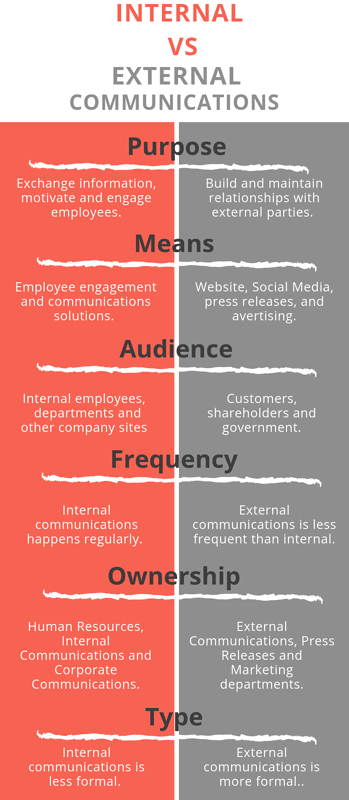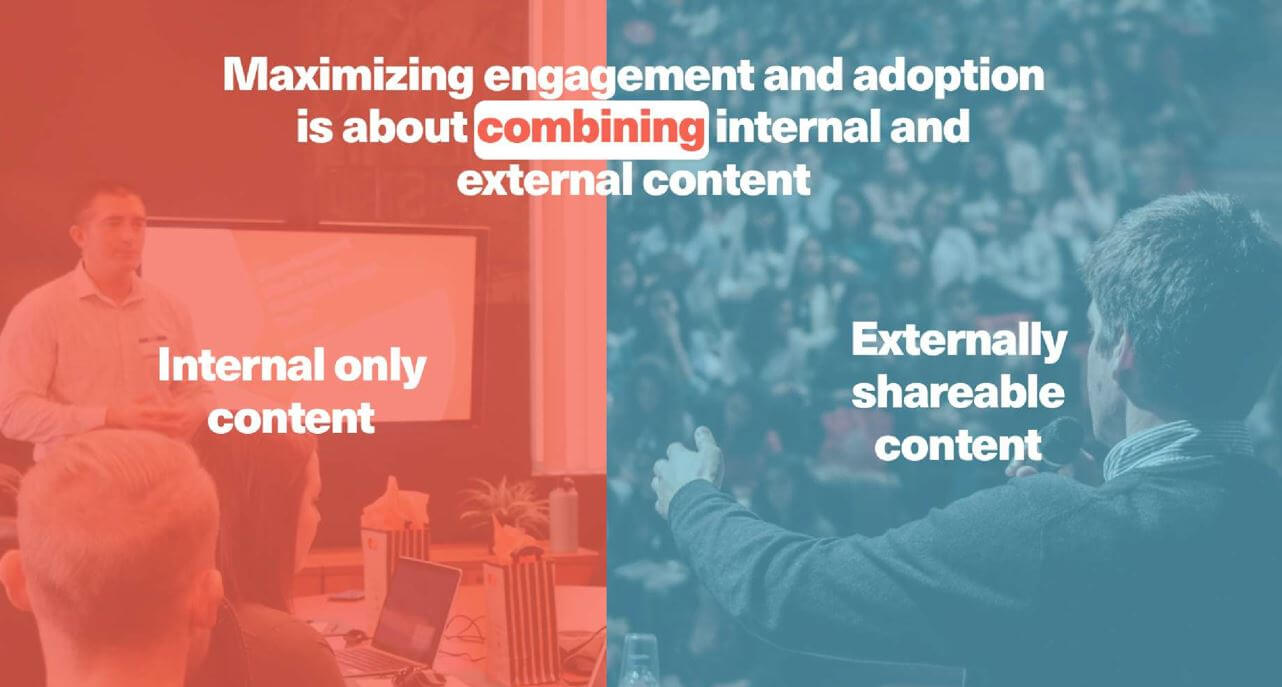Communications directors are responsible for delivering the right message to the right people at the right time. They play an extremely important role in organizational change.
What Are the Main Missions of a Communications Director?
Communications directors control the flow of information between an organization, its stakeholders, and the public. While directors of external communications supervise the information flow between an organization and the public, directors of internal communications take care of communications within the organization.
Along with the management of a communications team, communications directors determine marketing strategies, PR campaigns, employee communications, corporate communications, and engagement initiatives.
Make internal communications seamless with the right technology in place
External vs. Internal Communications
Before we move on to the communications problems in the workplace, we should first go through the differences between internal and external communications.
In general, these are the main differences:

Oftentimes, there are confusions about what professionals in charge of internal and external communications do.
So, let’s take a look at some of their duties and responsibilities.
What Does a Director of External Communications Do?
Directors of external communications possess crucial communications skills. Their main duties and responsibilities include:
- Developing a consistent external communications strategy
- Building and overseeing a diversely skilled communications team
- Managing crisis communication and preemptive planning
- Delivering key publications such as annual reports, investor and tenant newsletters
- Defining the brand’s tone of voice
- Identifying ways to improve the way information is shared to customers, investors and partners
- Ensuring that the digital media platforms used across the company are up-to-date – including websites and social media platforms
- Projecting a positive company image to the public
- Managing media relations
- Ensuring that digital and non-digital marketing materials are consistent with the brand
- Managing the PR, Marketing and Communications budget.
- Driving Public Relations activities
- Being the internal expert and go-to person for advice and support on PR activities
- Overseeing the company’s social media profiles
- Increasing the company’s presence at relevant public events
- Tracking the latest industry trends
What Does a Director of Internal Communications Do?
Some of the main duties of internal communications managers and directors include:
- Establishing an internal communications strategy in collaboration with senior managers
- Ensuring that organizational initiatives and projects are successfully communicated to employees and stakeholders.
- Ensuring that messages are consistent across all channels
- Responding to feedback from staff and adjusting internal communications accordingly
- Planning, writing, and editing content for a variety of internal communications mediums
- Ensuring that employees are not overwhelmed with irrelevant information
- Ensuring proper change management by continuously communicating with employees
- Conducting surveys on employee engagement and satisfaction
- Managing the internal communications budget
- Implementing new internal communications and employee engagement tools
- Planning and managing employee advocacy and brand ambassadorship programs in collaboration with directors of external communications
- Managing crisis communication and preemptive planning
- Cultivating an environment of readiness and alertness in the workplace
- Supporting HR and Marketing in employer branding and other talent acquisition activities
- Organizing events to promote the company’s employer brand and culture
18 Challenges Faced by IC Directors
IC is one of the main pillars of employee engagement. However, internal communications directors often face challenges when trying to improve workplace communications.
These are some of the most common challenges that directors of internal communications are facing today:
1. Lack of employee engagement
Communicating with employees is almost impossible within organizations where people are not motivated and engaged.
According to research, only 13% of the workforce is highly engaged, yet only 50% of executives know how to address this problem.
If you are not sure about all the benefits of having an engaged workplace, here is a great employee engagement report by Gallup.

Related: Employee Recognition Programs: An Expert Guide to Getting Started
2. Irregular communication
Communicating with employees just for the purpose of releasing big news or changes is not enough. Therefore, communications directors have to develop a continuous communications plan to keep their employees informed and engaged.
However, this can be too time-consuming because of a lack of resources.
3. Communication inconsistency
Inconsistent communication is another challenge that IC professionals are facing today.
If you don’t use an employee communications platform, it may be challenging to reach your employees at the right time. Having an employee communications app is critical when it comes to keeping your employees informed and engaged.
4. Information silos
Information silos is a term used for situations when information just gets lost. This is one of the main problems that directors of communications are facing, especially in large organizations.
5. Lack of feedback
Something that communications and HR professionals wish to have more is employee feedback.
Employee feedback is closely correlated with employee engagement and satisfaction. Therefore, a lack of feedback may result in lower employee engagement rates in the workplace.
6. No inter-departmental communication
In today’s agile world, internal communications directors need to ensure much better interdepartmental communications.
For example, product development, marketing, sales and customer success teams cannot work separately. In order to be successful, they need to communicate effectively on a daily basis.
According to research, over half of the companies report having siloed teams, and 40 percent of organizations admit that each different department has its own customer experience agenda.
7. Wrong communications technology
This one is extremely important!
There are so many tools for employee relations and communications. However, they are mostly emails and company-wide newsletters that employees don’t like to use. Irrelevant information is usually the main reason why emails don’t work anymore.
Therefore, IC directors have to be ready for technology changes. Implementation of modern employee engagement solutions can be a crucial step for eliminating communications problems in the workplace.
Since the relationship and collaboration between internal communications and IT departments is crucial for the successful implementation of the new technology, we have prepared for you an interesting online session.
8. Email overload
Did you know that most organizations are still using emails as their channel #1 for their internal comms while employees’ email inboxes are fully packed?
Newer employee communications apps are designed so that the flow of information is much faster, errorless, and more efficient.
If you are trying to keep millennials and younger generations within your organizations, it is important that you implement modern software solutions.
9. Irrelevant content
Same as we expect from our favorite social media platforms to show relevant content in our news feeds, today’s employees expect their employers to share the right information at the right time.
If this is not the case, employees are much less engaged as it gets very hard to find relevant information.
10. Lack of knowledge sharing
Only 25 percent of senior executives say their organizations are sharing knowledge in an effective way. The other 75 percent are taking a financial hit: Fortune 500 companies are reportedly losing an estimated $31.5 billion per year by failing to share knowledge across teams.
Here are the top 3 factors influencing knowledge sharing success:

11. Lack of collaboration
Encouraging cross-departmental collaboration is the key when it comes to building a successful business. In fact, high-performing organizations are 5.5 times more likely to encourage collaboration across teams than lower-performing organizations.
Even those who may not be collaborating efficiently yet still recognize the importance of collaboration in the workplace: 3 out of 5 companies say that the solution to reaching their goals is collaboration across functions. And 94 percent of organizations say agility and collaboration are essential to their success.
12. Language barriers
Since we live in a world where employees can work from any part of the world, language barriers have become a big challenge for communications directors.
If you want to drive employee engagement, you need to make sure you build your content distribution based on your employees’ locations and the languages they speak.
13. Drop in employee productivity
Not being able to find relevant information has a big impact on employees’ productivity. In fact, we have found that the average knowledge worker spends 2.5 hours a day searching for information. This is more than one entire week lost every month.
Therefore, communications directors should work toward helping employees find information faster.

14. Keeping remote workers engaged
Not having a centralized employee communications tool can hurt your relationships with remote workers. Remote work trends are rapidly growing, and communications directors need to have a plan on how to keep remote workers informed and engaged.
15. Lack of employee advocacy
Something that most directors of communications are trying to achieve is employee advocacy. It is great to have good internal information flow, but keep in mind that your employees can actually help you take your internal communications to the next level by sharing informative and educational content internally.
Employee advocacy and brand ambassadorship are extremely powerful in Marketing, Sales, Employer Branding, and Talent Acquisition.
16. Lack of fun
Making your internal communications fun is one of the best ways to drive engagement and adoption. There are various employee engagement solutions today that can add some fun to your employee communications efforts.
17. No ways to measure internal communications success
Measuring internal communications efforts is one of the main challenges directors of internal communications are facing today. The same goes for showing the internal communications and employee advocacy ROI.
Here, the focus should really be on measuring the impacts of your internal communications on employee engagement, motivation and productivity.
Also check our ROI calculators.
18. Budget limitations
Last but not least, communications directors are often struggling to get bigger budgets. Most communications budgets still go to marketing and external comms departments.
However, it is expected that IC budgets will increase dramatically, as employee engagement is becoming more important.
6 Tips for Internal Communications Directors: How to Eliminate Communication Problems in the Workplace
As explained earlier, communications directors are facing a lot of challenges.
Therefore, we are giving you a few crucial tips for improving your internal communications strategy.
1. Support the #NoSearching revolution
At Haiilo, we believe that employees should not have to search for information. We believe that relevant information should find employees. This is what we call the #NoSearchingRevolution in the world of employee communications.
As discussed earlier, searching for information can have a very negative effect on employee satisfaction, engagement, and productivity in the workplace.
Therefore, directors of communications should put some extra work into delivering the right information to the right employee at the right time.
2. Implement the right technology
HR tech has been evolving rapidly in the past few years. There has been a focus on developing platforms for employee communications and engagement.
Therefore, internal communications directors have to be ready to adopt these new technologies. They should be ready to switch from some old solutions such as emails and look for some better alternatives.
3. Educate employees
In order to encourage your employees to engage more with your content, you need to educate them on how to do so. For example, if you want your employees to engage in an advocacy program, it is crucial to explain how the program works.
There are many employees that are happy to spread the word about your company, but they may be unsure about the information they can share.
4. Ask for employees’ feedback
Internal communications directors should ask employees for feedback right after implementing a new communications strategy. This is one of the best ways to get real insights on what is working well and what needs to be improved.
5. Make it fun
Make employee communications fun and more interactive. Today, there are tools that have user interfaces very similar to social media platforms that your employees love using.
When choosing the right technology, make sure to look for a user-friendly solution with gamification features.
In addition, make sure that your new solution enables you to maximize the power of employee engagement.
6. Maximize the power of employee engagement
As mentioned earlier, happy employees want to be your brand ambassadors. Therefore, finding a solution that will not only help you communicate with employees but also enable them to share content externally is the real goldmine.

If you are a director of internal communications, schedule a Haiilo demo to learn about how the right technology can help you overcome the biggest communication challenges in the workplace. 👇










